We all focus on the ability to start a fire as the most important survival skill to master.
Each survival instructor tries to outdo the last, coming up with a newer and more unusual way of starting a fire. While all of those methods work and may even be useful at some time, they’ll only be useful if we’re not prepared to start it in an easier way.
There’s no reason to make a lens out of a chunk of ice you cut from a frozen stream or use a bow drill to get a lump of coal glowing if you’ve got a good stormproof lighter to work with.
But none of those fire starting methods are going to any of us the least bit of good unless we’ve got something to burn. Yet I see very little said about cutting and splitting the wood for that fire. The little I do see is associated with a bug-out bag and is mostly concerned with building a temporary shelter.
Related: 12 Woodworking Projects for Preppers and Homesteaders
In other words, you really wouldn’t want to cut firewood with a pocket chain saw.
But if we’re going to heat our homes with wood, we’re going to have to face the fact that we’re going to be cutting and splitting a lot of logs. Even if we have a chain saw available to us, we’ll eventually run out of gasoline for it. Gasoline doesn’t store very well, so don’t be expecting to use that chain saw for several years after the power goes out.
You’ll be lucky if it’s still running after six months.
You’ll need a lot of firewood if you’re going to be heating with wood. People in the northern part of the United States, who are heating with wood, tend to burn somewhere between four and six cords of wood per winter; that’s good hardwood too; not pine.
Related: How to Store and Stack Firewood The Right Way
That means having the right tools for cutting down those trees, bucking then down to the width of your fireplace or wood-burning stove, and then splitting the logs into usable chunks of wood. It’s much easier to get the wood to burn, if the heartwood is exposed, rather than just bark, so it’s always a good idea to split your wood unless the pieces are so small as to be nothing more than kindling.
Let’s Clarify Something
Before looking at some specific tool types, I want to clarify something; the difference between axes and mauls. A lot of people equate the two as if they are the same. But they’re not. While both are useful in this process of getting wood for your fire, they can’t be used interchangeably.
The basic difference between the two is the width of the head. An axe head is narrow, and might even be hollow ground to make it narrower. It also needs to be sharp. That’s because the purpose of the axe is to cut across the grain of the wood, as you would have to, to fell a tree.
In fact, you’ll probably want to sharpen it every time you use it, because the steel is relatively soft and can dull quickly. But the narrow head is virtually worthless when trying to split wood.
In contrast, the maul has a much thicker head, even though most mauls look a lot like an axe. While it is helpful for a maul to be sharp, that isn’t as critical as it is for an axe. Rather, the key to a maul is leverage. As you drive it into the wood, the broad head puts a lot of side-pressure against the grain of the wood, separating it and causing it to split.
However, that broad head makes it all but impossible to cut a tree down with a maul.
Now, on to the best types of wood cutting tools to have for gathering and splitting that wood. While my intent is to give you categories of tools, more than specific models, I am mentioning a few specific models that have unique features or provide unique methods that make them better than the average.
Related: 26 Necessary Tools for Off-Grid Living
Felling Axe
The felling axe is your basic tree felling tool. What makes it unique, as compared to other axes, is that it has a long, curved handle, which provides a lot of leverage. That leverage coverts directly to the speed the axe head is moving when it strikes the tree, which ultimately leads to a deeper cut.
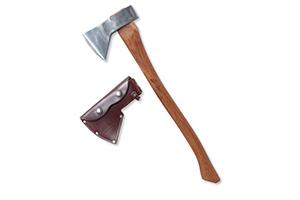 Some people prefer a double-headed axe, because it allows them the option of having one bit sharper than the other or of going a longer time between sharpening.
Some people prefer a double-headed axe, because it allows them the option of having one bit sharper than the other or of going a longer time between sharpening.
But that larger head is heavier, making it harder to wield the axe. As opposed to splitting wood, where weight converts into a greater downwards push from the mail, you have to hold up the weight of that heavier axe head while swinging it horizontally. Unless you’re extremely muscular, that’s hard to do.
I wouldn’t cut corners, buying a cheap felling axe, as that will mean cheaper steel, which won’t stay sharp as long, just like a cheap knife. I also like the idea of buying an axe that comes with a blade cover, as that protects your newly sharpened blade.
Crosscut Felling Saw
There are times when cutting down a tree with an axe just isn’t practical, especially with a larger diameter tree. In those cases, you really need a saw. Since we’re assuming you can’t use a chain saw, that means a crosscut felling saw, which can be a bit hard to find.
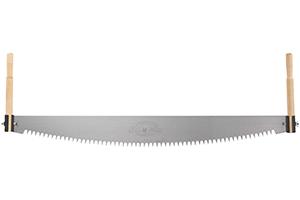 This is the old-fashioned saw that lumberjacks used, before they got their chainsaws. While we all have an image of lumberjacks with axes over their shoulders, they more often than not used a two-man saw of this type.
This is the old-fashioned saw that lumberjacks used, before they got their chainsaws. While we all have an image of lumberjacks with axes over their shoulders, they more often than not used a two-man saw of this type.
Then they would use their axes to cut off branches and prepare the logs for cutting to length. With large enough trees, they’d even cut them to length with this sort of saw.
Buck Saw
When it comes to bucking your logs down to a size that will fit in the fireplace, there’s nothing that I’ve found which beats an old-fashioned buck saw.
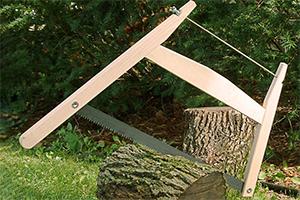 As far as I know, there’s only one place in the country still selling these, but they work just as good as ever; perhaps better, as they are using better quality steel for the blade.
As far as I know, there’s only one place in the country still selling these, but they work just as good as ever; perhaps better, as they are using better quality steel for the blade.
A buck saw of this type will make much shorter work of bucking branches and trunks down to a usable length, than a bow saw will. It’s also going to be easier on your hands and capable of handling larger diameter logs.
Splitting Maul
Your basic splitting maul is heavier than an axe, although I’ve seen some that are a bit on the light side. But the heavier it is, the more momentum you’re going to get on the downswing, resulting in more force behind that blade edge when it hits the end of that log you’re trying to split.
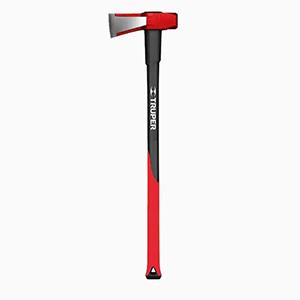 When looking for a splitting maul, concentrate on the shape of the head. The wider an angle it makes, the better. But that doesn’t mean that you want the whole head the same width. You’re actually better off with a head that has narrow protrusions out the sides, rather than the whole head being wide.
When looking for a splitting maul, concentrate on the shape of the head. The wider an angle it makes, the better. But that doesn’t mean that you want the whole head the same width. You’re actually better off with a head that has narrow protrusions out the sides, rather than the whole head being wide.
What that will do for you is reduce the friction, allowing the maul’s head to sink farther into the log, which results in more splitting force.
If you can handle the weight, a heavier head is an advantage too; as it will gain more momentum on the downswing, resulting in a harder hit. But watch out, even one extra pound can wear you out quickly if you’re not up to the challenge.
Chopper 1 Maul
The Chopper 1 Maul is a uniquely engineered splitting maul, which has spring-loaded levers on the sides of the head. As the blade enters into the log, these catch on the end, swinging out to the sides, pushing the two sides of the log apart.
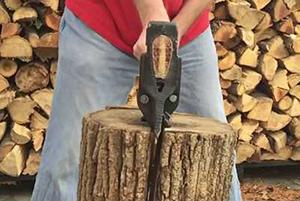 This increases the leverage considerably, making it possible to get much more lateral splitting motion out of each stroke.
This increases the leverage considerably, making it possible to get much more lateral splitting motion out of each stroke.
It takes a lot of force to wield, as you have to get the blade into the log far enough to engage the levers, but you have to do that anyway to split the log with any maul.
The only possible disadvantage of this maul is that the springs and levers could break rendering it less than efficient to use. However, from everything I can find, looking at reviews online, this doesn’t seem to be an issue.
Leveraxe
The Leveraxe is a total redesign of the splitting maul. While called an “axe” I don’t see any way this can be used to chop down a tree; every advertising video they have of it, shows it being used as a splitting maul, and it’s extremely efficient at that. It’s also fairly lightweight, making it much easier to use.
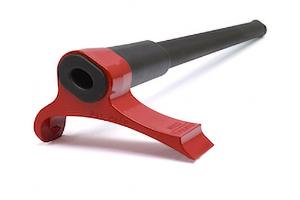 The whole thing about this tool is that it uses leverage to great advantage.
The whole thing about this tool is that it uses leverage to great advantage.
The head is out of line with the blade, so that as the blade strikes the log, it automatically twists to the side, prying the wood. This unique chopping action makes it about the easiest log splitter there is to use, especially for people who are not all that strong.
Kindling Cracker
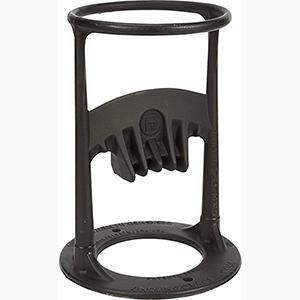 The Kindling Cracker takes splitting logs and turns it on its head. Rather than having the blade on the handle, it puts the blade in a holder, which the wood is then set into. To split the wood, a sledgehammer is used.
The Kindling Cracker takes splitting logs and turns it on its head. Rather than having the blade on the handle, it puts the blade in a holder, which the wood is then set into. To split the wood, a sledgehammer is used.
For those who don’t split wood very often, this tool offers the advantage that you don’t have to have a good aim with your tool.
If you are prone to hitting the wood with the maul at the wrong angle and deflecting off to the side, this is the tool for you.
Hydraulic Log Splitter
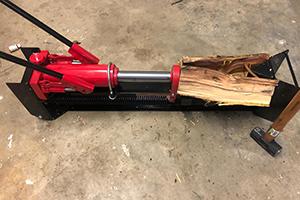
If you buy split firewood, it has probably been split using a gas-powered hydraulic log splitter.
Of course, if you don’t have gasoline to run your chainsaw, you’re not going to have gasoline to run your hydraulic splitter either. That is, unless you have a splitter that isn’t gas driven.
There aren’t too many manually-powered hydraulic log splitters out there, but there are a few.
This is the ideal tool if you’re going to have someone that’s not all that strong doing the work. While slow, compared to the other methods we’ve talked about, a manual hydraulic log splitter is easy to use. In fact, it’s actually easy enough for the kids to use.
You may also like:
Never Throw Away Your Wood Ash! Do This Instead
The U.S. Army’s Forgotten Food Miracle (Video)
How to Make Firebricks (fire logs) and Wood Stove Logs for Free!

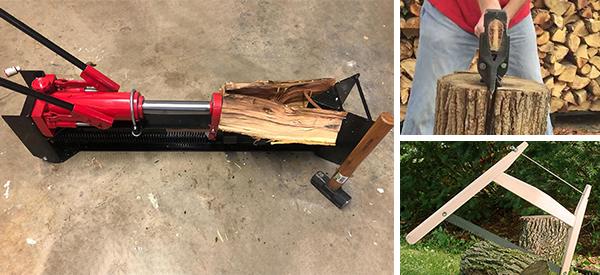














We have several axes, mauls and even a 6′ felling saw as back ups to our chainsaws, I can split more wood with my maul than my son does with the gas powered woodsplitter for about an hour. But I am stiff and a little tired after! 😛
This useful article does overlook another relatively-safe, old-school way to effectively split wood. In addition to easily splitting most oak with an ax or maul, I often use a pair of steel wedges for tougher wood like Hickory. You can drive them through with the back of a maul or with a sledge hammer, alternating each as the split widens. This also minimizes the chance of hurting yourself with a glancing blow from an ax or maul driven directly into the log with great force.
Wedges are my first option, unless the grain is sorta straight.
Also I can work with them a lot longer than an ax or maul.
Half swing taps rather than full power, wind up strokes.
I have 5 wedges and my record is burying three before loosening things up.
Thanks for all the excellent programing, please keep it up!
The root cellar/ Bunker cannot be built for a few hundred bucks, as stated in your testimonial I purchased your e-book Very disappointed maybe 20 years ago, have you priced sand bags lately you really should update your video with current pricing kind of disseptive
I always preferred to use a two-man saw to a chainsaw. In the long run, they’re easier and make the work enjoyable. But, long before saws, when exes were made of stone, people used a controlled fire to take down forest giants. Once the tree was down, the log could be split using wedges and mauls, then burned into manageable pieces for building material or firewood. niio
I got to work with an old logging chainsaw that had a 48″ bar, it was like holding a motorcycle sideways to fell a tree. The 2 man saw is much better. Today we don’t realize what ‘forest giants’ were, I’ve seen pics taken when they were 1st logging the New Mexico mountains of a western red cedar they have cut the wedge into before dropping it, two loggers are posed standing up inside the wedge, the forests before my Euro brothers came were beyond our imagining.
All credit to the article for recommending the bucksaw, bow saws aren’t worth buying.
Don’t split wood in the middle of the night after a few drinks barefoot wearing only your boxers like I did last year right before I broke my big toe…
Mike: I’m happy you didn’t lose that toe. the bad news about old-growth forests is, they have a symbiosis with fungus. Pleats need CO2 and can’t get enough. They drop leaves and needles, and then branches. They sacrifice parts of themselves to get more CO2. When the Navajo were selling trees, planting hundreds of acres, they cut the trees down after 25 years because that’s the top age for a tree to eat up more CO2 than it needs to make to survive. Eastern American Indians burned off older forests because almost nothing could survive in and under them. Think Dolly Parton’s small feet. A few years after the fire, deer would birth twins and triplets on good feed.In the older growth, a doe might have one fawn every two years and starved to death on her fourth one. niio
When the white man first visited Yosemite Valley, it was a lush open meadow. The local folks (commonly called Indians) used to burn the valley each fall. In the spring lush grass grew up and the deer came down from the higher peaks to graze on the fresh green grass and that made hunting them so much easier than chasing them through the tall forests growing on the hillsides.
Even into the early 60s when I first visited the valley it was much more open than it is today. Of course with the misguided forest service (what a misnomer) the policy is to not destroy any trees. Trees are sacred (Is it true the forest service is run by Druids?) Thus the valley is now overgrown and while deer still come down because they are driven by lack of forage and no hunting in the park the herds are not healthy because there are too many old deer that consume the limited forage to the detriment of the fawn crop.
In my opinion the whole ecology of the entire PDRK is screwed up due to mismanagement.
chuck: Fact! And mountain lions would rather take a human than a deer. A human is helpless against one, and they know it. Even if a man is armed, with no hunting them allowed, they would still try.
the Great Plains are turning to brush ground because no burning is allowed unless you have permission from the state. Entire forests are dying to insect pests and diseases because forest fires are not allowed to burn. Northwest, the eco-freaks were embarrassed to find ore spotted owls in Seattle than in those scared forests. there was little for them to eat in old-growth forests. Anyone who’s family has lived on the land knows the area better than someone living in a swamp thousands of miles away, but that’s big government/socialists. One size fits all. niio
I’m not sure the picture you have is a two man felling saw. It appears to be a bucking saw. A felling saw is fairly narrow from end to end so you can drive wedges in behind them as you cut. But overall a good article.
The two man saw you have pictured is a two man bucking saw for blocking up felled trees. A felling saw is much narrower and is the same width end to end. The narrower blade is not so likely to pinch in a felling cut. I have used both when I was young, started pulling a bucking saw opposit my older brother when i was five years old while Dad and my other brother went in the woods with the felling saw and horse to cut and skid the next tree out to the wood yard. I have also split many cord of fire wood with a double bitted axe and used a sledge hammer and wedges for the knarly blocks. These days I do appreciate chain saws and gas wood splitters.
PS,
For anything larger than small limbs, at the most six inches, A four or five foot one man bucking saw beats the bow style saw shown.
you want the hand tools for sure – but making sure to keep fuel available for the labor & time multipliers like chain saws and a hydraulic splitter could be the difference in your survival …
I don’t mean to Nit-Pick, but your estimate for a winter’s wood burn is more like 10-30 face cord.
2 variables, how cold it gets and how well the house is insulated. We used to burn 32-36 face cord, then my parents insulated the house really well and we got it done to 10-18 cord.
Hi Rich: I’m an old bloke that’s been splitting hardwood for 40 years and I was really impressed with the design of the splitting Maul in your article.
I went to my local hardware store Bunnings (very big here in Australia) and bought a new one of that same configuration. It also had a beaut unbreakable plastic handle. Couldn’t wait to try it out, but boy was I disappointed.
Gets stuck all the time (just like an axe) and then the handle is so flexible, and the angle of the head so shallow that you can’t just bump down with a gloved hand and jolt it free.
I’m back with my old Hickory handled splitter with the same course angle right across the head and dearly loving it.
If you buy one make sure it’s from a place that will take it back if you don’t like it!
Wedges are my first option, unless the grain is sorta straight.
Also I can work with them a lot longer than an ax or maul.
Half swing taps rather than full power, wind up strokes.
I have 5 wedges and my record is burying three before loosening things up.
I made a version of the kindler using two car tires bolted together. Throw in a log and start splitting. The tires keep the wood pieces from flying all over the place as you split.
Unlike the kindler, there is no metal rim that can damage the handle of the axe.
Dan: sounds good. We used two tires running in opposite directions to dehull black walnuts. Here’s a modern version of what we did. did you get frost yet? niio
https://www.youtube.com/watch?v=47F6GQRFm0E
I’ve used many different wood cutting tools, but I have to say that my favorite is the one from Woodcraft. It’s a great product and it cuts through wood like butter! The handle is ergonomic, lightweight and comfortable to use. You can even change out the blade for another if you need a bigger or smaller size. My girlfriend loves this tool as well because she has arthritis in her hands so it helps relieve some of the pain when using these types of tools. I highly recommend this product to anyone who needs something like this for their shop or garage work!
Robert: Using hand tools means quiet, even peaceful hours. Definitely something people under stress need to do.
When arthritis hits, I use Korean accu-pressure, just finger pressure and very gently pull on a finger, give it a small twist, hold 20 seconds, then wait 20 more and do it in the opposite direction. This forces blood into the area and helps heal things. niio